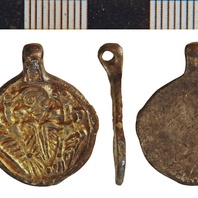
Viking Objects
Pendant with an Odin Motif (NLM-7F954A)
A cast silver, gilded pendant featuring an image which has been interpreted as representing the one-eyed god Odin and his two ravens Huginn and Muninn. There are a number of close parallels which establish the wide currency of this subject group. These include numerous examples from Russia and two from Sweden, including some with silver gilding. A silver pendant with a related, but distinct design is known from Sjælland, Denmark. With some exceptions, pendants were generally worn by women as part of their Scandinavian dress.
Read More
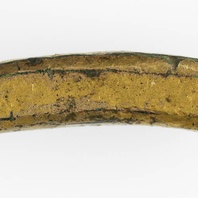
Viking Objects
Forged Hack-gold Rod (CM 595-2010)
This forged hack-gold rod comprises a curved section of gilt copper-alloy. It is square in cross-section and is broken at both ends. It shows that someone near Torksey was trying to con others by passing copper-alloy as gold. Like hacksilver, hack-gold was used to pay for items by weight of precious metal. The buyer and seller would agree the value of an item and pieces of silver or gold would have been cut up and weight out until the right amount had been paid. Gold was much less common among the Vikings than silver.
Read More
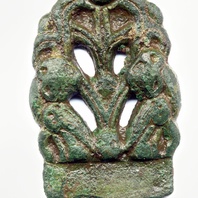
Viking Objects
Anglo-Scandinavian Strap-End (LEIC-0C2B81)
This example of an Anglo-Scandinavian copper-alloy strap-end displays foliate decoration and features a mixture of the Anglo-Saxon Winchester style and Anglo-Scandinavian zoomorphic heads. It is classified as Thomas Class E, Type 1.
Read More
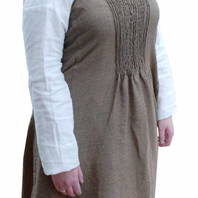
Viking Objects
Reproduction Women’s Clothing Set
The woollen strap-overdress is brown broken-diamond twill. A complete example of this dress has never been found, but this reconstruction is based on a composite of known archaeological finds. The narrow straps are often found mineralised inside the brooches, the pleated front section is based on an archaeological find from Køstrup, in Denmark, and the asymmetrical back panels are based on an original find from Hedeby, in Denmark. The underdress is of bleached linen, based largely on small traces of archaeological material from Birka, Sweden, Dura, Finland, and contemporary depictions. The woollen cloak is of thick yellow diamond twill with fringed edge. The vegetable-tanned leather toggled turnshoes are based on originals found during excavations at Coppergate, in York.
Read More
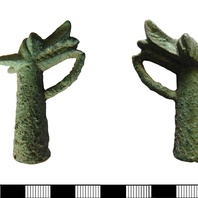
Viking Objects
Drinking-Horn Terminal (LIN-F0DD46)
This probable drinking horn terminal has a hollow conical socket with three rivet-holes at the attachment end. The socket is ribbed and at the top it has an integral animal head in the form of a mythical creature, most likely a dragon.
Read More
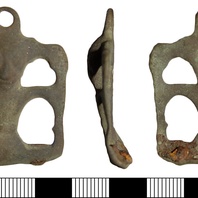
Viking Objects
Stirrup-Strap Mount (BH-D273BF)
This copper-alloy stirrup strap mount is classed as a Williams Class B Type 2 and is decorated with an openwork zoomorphic design.
Read More
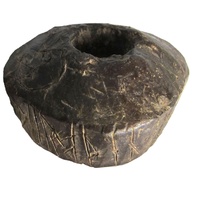
Viking Objects
Saltfleetby Spindle Whorl (LIN-D92A22)
A lead spindle whorl found at Saltfleetby St Clement, Lincolnshire, and inscribed with runes. The dating of the spindle whorl is uncertain, and dates in the late Viking Age, the early eleventh century, or even the twelfth century, have been suggested. The spindle whorl is inscribed with Scandinavian runes that appear to mention the Norse gods Odin and (possibly) Heimdall. The object is likely to have been produced locally, though the runes demonstrate contacts with the Scandinavian world of the time, perhaps especially Norway. John Hines has suggested the translation ‘Óðinn and Heimdallr and Þalfa, they are helping you, Úlfljót, and …’. For further discussion of the text, see the open-access article by Jesch referenced below. For more on runes, see our Runes page.
Read More
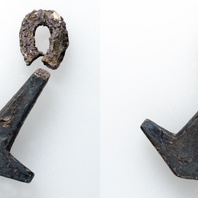
Viking Objects
Thor’s Hammer Pendant (1989-59/7224)
A silver hammer-shaped pendant found in Grave 511 at Repton. This is the grave of a man who appears to have died violently, taking a vicious cut to his loins. These may have been worn to show devotion to the god Thor, or to secure the god’s protection, although there is little evidence to support this interpretation. Pendants like this have been found made of lead, copper alloy, silver and gold, showing that many different strata of society could have worn them.
Read More
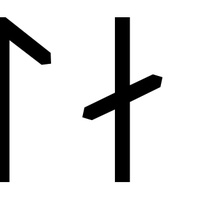
Viking Names
Aslak
The male name Áslákr is common in Norway in both the Viking Age and later, and also occurs in a few runic inscriptions from Denmark and Sweden. It forms the first element of the Nottinghamshire hybrid place-name Aslockton and is also found in Aslackby in Lincolnshire.
Read More

Viking Names
Bark
The Old Norse male personal name Barkr originated as a byname. The name is related to the Old Norse noun bǫrkr (genitive barkar) ‘bark’. One of the settlers of Iceland bore the form Bǫrkr and the name appears as an element in a few Western Scandinavian place-names. Bark is found as a byname in Sweden. Barki is potentially a side-form of Barkr or could be from barki ‘throat’- also a byname. Barkr is the first element in the place-name Barkby, Leicestershire and this place-name was later affixed to Barkby Thorpe, its daughter settlement.
Read More
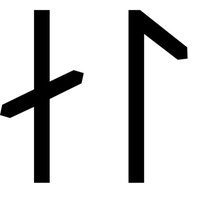
Viking Names
Val
Valr is an original byname meaning ‘hawk, falcon’. Valr is recorded as a male personal name and byname in West Scandinavia and is found in a Swedish runic inscription. Valr is the first element in the place-name Walesby, Nottinghamshire, and a place of the same name in Lincolnshire. Walshcroft Wapentake in Lincolnshire also contains either this name or the Old Norse male name Váli and Old Norse kross, the cross probably marking the location of the Viking Age meeting-place. Cameron suggests that the same man gave his name to Walesby and the wapentake.
